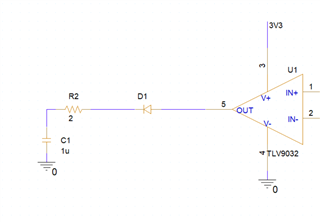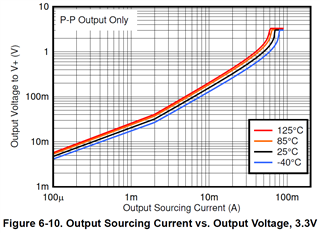Hello,
I am using the TLV9032 comperator. In the output i have series diode and resistor of 2 ohm and capacitor to groung of 1uF.
The comperator can handle this load without exceeding the stress?

Thank you
This thread has been locked.
If you have a related question, please click the "Ask a related question" button in the top right corner. The newly created question will be automatically linked to this question.
Hello,
I am using the TLV9032 comperator. In the output i have series diode and resistor of 2 ohm and capacitor to groung of 1uF.
The comperator can handle this load without exceeding the stress?

Thank you
From the simulation i did, the current goes up to 45mA:


The absolute maximum ratings do not limit the output current itself, but limit the duration of a short circuit to 10 s. So if this does not happen too often, you should be fine.
What is the purpose of this circuit? If you want a latched output, consider using a flip-flop.
Hi Clemens,
This pulse happens every 10ms, is it ok?
The purpose of this circuit is to detect high current in the positive input and stop the current by closing a series fet from the output of the comparator. I have already layout so i cant make changes.
Thank you
I doubt that the FET has a gate capacitance of 1000 nF.
Anyway, this should be OK.
Hello Maor,
The peak charge current will be limited by the current limt.
The current limit can be seen as the sharp upward peak in the sourcing current graph

The current limit is about 70mA at room temp.
Electrically, it will not damage the device, but it will cause a rise in die temperature.
The duty cycle of the pulses (ratio of pulse width to rep rate) will determine the ultimate total die temp rise. So you need to ensure that the die temp does not rise above 125C (including ambient).
Hi Paul,
The temp rise is that?
3.3V*90mA*duty*238
238 = junction to ambient thermal resistance
Thank you
Hi Maor,
In simple terms, yes. A steady-state DC short would eventually destroy the device. Low power devices like these usually do not have thermal protection. The pulse is exponential, not square, so it is a little more complicated than a simple pulse. In short, the higher the rep-rate, the higher the die temp.
While I hate to promote competitors, ON does have an excellent appnote on pulsed thermal heating calculations:
Hi Paul,
Lets say the pulse on time is 20 sec and the off time is 1000 sec, the device will destroy but the duty is 2% so from the formula the temp rise will be very low (1.4 degrees). The formula should include the on time?
Thank you